ActiveOutdoorsOutdoor TechCelestron StarSense Explorer DX 130AZ telescope reviewThe Celestron StarSense Explorer DX 130AZ Newtonian reflector telescope uses a planetarium app to find heavenly bodies, but targeting it is a surprisingly manual affair. Here’s our reviewWhen you purchase through links on our site, we may earn an affiliate commission.Here’s how it works.(Image credit: Jamie Carter)T3 VerdictThe Celestron StarSense Explore DX 130AZ is aimed at beginners yet needs to be moved completely manually. Luckily there’s an app and a smartphone mount on hand to show you exactly where to point it. It helps the user learn to navigate the night sky and gives super-sharp views of the treasures within it.Reasons to buy+Simple set-up+Easy to align+Sharp images+All-in-one packageReasons to avoid-No astrophotography possible-Manual slewing-Eyepieces are limited-Requires collimationWhy you can trust T3Our expert reviewers spend hours testing and comparing products and services so you can choose the best for you.Find out more about how we test.
ActiveOutdoorsOutdoor TechCelestron StarSense Explorer DX 130AZ telescope reviewThe Celestron StarSense Explorer DX 130AZ Newtonian reflector telescope uses a planetarium app to find heavenly bodies, but targeting it is a surprisingly manual affair. Here’s our reviewWhen you purchase through links on our site, we may earn an affiliate commission.Here’s how it works.(Image credit: Jamie Carter)T3 VerdictThe Celestron StarSense Explore DX 130AZ is aimed at beginners yet needs to be moved completely manually. Luckily there’s an app and a smartphone mount on hand to show you exactly where to point it. It helps the user learn to navigate the night sky and gives super-sharp views of the treasures within it.Reasons to buy+Simple set-up+Easy to align+Sharp images+All-in-one packageReasons to avoid-No astrophotography possible-Manual slewing-Eyepieces are limited-Requires collimationWhy you can trust T3Our expert reviewers spend hours testing and comparing products and services so you can choose the best for you.Find out more about how we test.
The Celestron StarSense Explorer DX 130AZ Newtonian reflector telescope uses a planetarium app to find heavenly bodies, but targeting it is a surprisingly manual affair. Here’s our review
When you purchase through links on our site, we may earn an affiliate commission.Here’s how it works.
(Image credit: Jamie Carter)T3 VerdictThe Celestron StarSense Explore DX 130AZ is aimed at beginners yet needs to be moved completely manually. Luckily there’s an app and a smartphone mount on hand to show you exactly where to point it. It helps the user learn to navigate the night sky and gives super-sharp views of the treasures within it.Reasons to buy+Simple set-up+Easy to align+Sharp images+All-in-one packageReasons to avoid-No astrophotography possible-Manual slewing-Eyepieces are limited-Requires collimation
(Image credit: Jamie Carter)
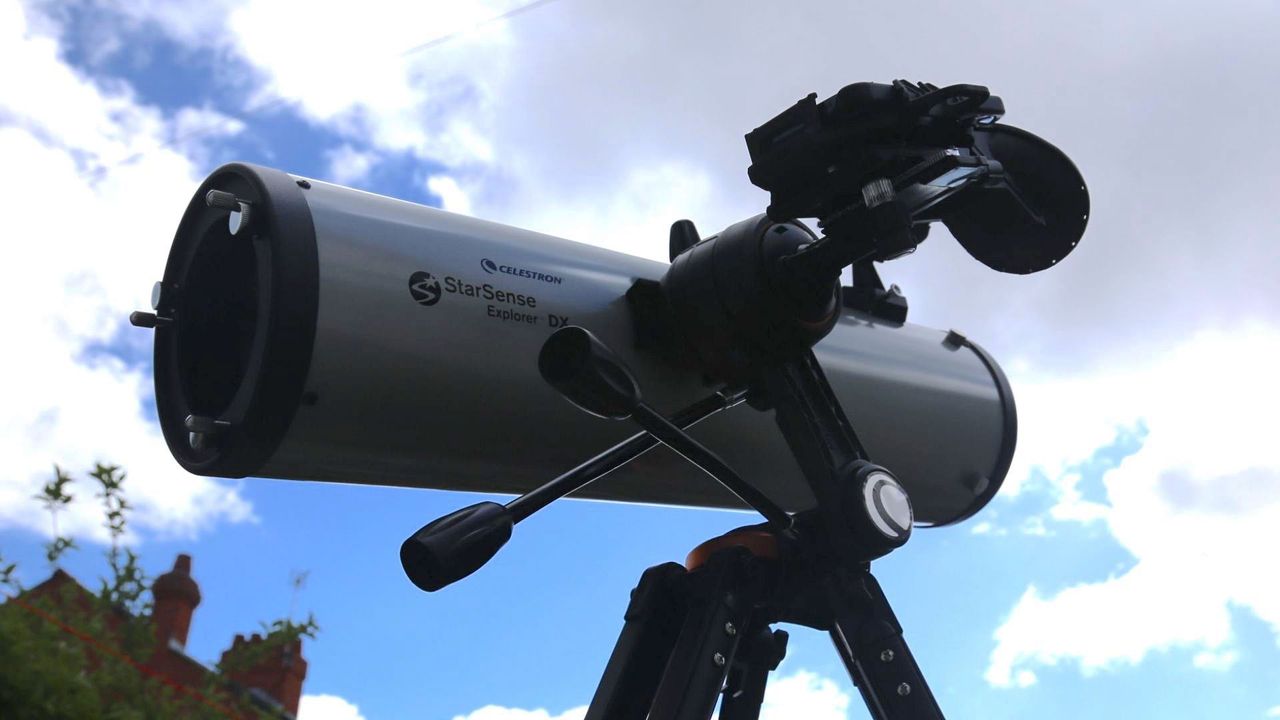
(Image credit: Jamie Carter)
T3 VerdictThe Celestron StarSense Explore DX 130AZ is aimed at beginners yet needs to be moved completely manually. Luckily there’s an app and a smartphone mount on hand to show you exactly where to point it. It helps the user learn to navigate the night sky and gives super-sharp views of the treasures within it.Reasons to buy+Simple set-up+Easy to align+Sharp images+All-in-one packageReasons to avoid-No astrophotography possible-Manual slewing-Eyepieces are limited-Requires collimation
T3 VerdictThe Celestron StarSense Explore DX 130AZ is aimed at beginners yet needs to be moved completely manually. Luckily there’s an app and a smartphone mount on hand to show you exactly where to point it. It helps the user learn to navigate the night sky and gives super-sharp views of the treasures within it.
T3 Verdict
The Celestron StarSense Explore DX 130AZ is aimed at beginners yet needs to be moved completely manually. Luckily there’s an app and a smartphone mount on hand to show you exactly where to point it. It helps the user learn to navigate the night sky and gives super-sharp views of the treasures within it.
Reasons to buy+Simple set-up+Easy to align+Sharp images+All-in-one packageReasons to avoid-No astrophotography possible-Manual slewing-Eyepieces are limited-Requires collimation
Reasons to buy+Simple set-up+Easy to align+Sharp images+All-in-one package
Simple set-up
Easy to align
Sharp images
All-in-one package
Reasons to avoid-No astrophotography possible-Manual slewing-Eyepieces are limited-Requires collimation
No astrophotography possible
Manual slewing
Eyepieces are limited
Requires collimation
Why you can trust T3Our expert reviewers spend hours testing and comparing products and services so you can choose the best for you.Find out more about how we test.
Why you can trust T3Our expert reviewers spend hours testing and comparing products and services so you can choose the best for you.Find out more about how we test.
Celestron StarSense Explorer DX 130AZ Smartphone App-Enabled Telescope deals
$365.49View$365.49View$479.95$365.99View
$365.49View
$365.49View



$365.49View
$365.49
$365.49
$365.49View
$365.49View
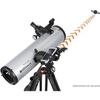

$365.49View
$365.49
$365.49
$479.95$365.99View
$479.95$365.99View
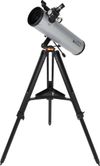

$479.95$365.99View
$479.95$365.99
$365.99
We check over 250 million products every day for the best prices
The Celestron StarSense Explorer DX 130AZ reviewed here belongs to a select band of all-new telescopes that use the technology found in smartphone apps to help you explore the night sky. You’ve probably already got an augmented reality ‘planetarium’ app on your phone that shows you stars and planets. This telescope uses its own version of one of those apps and asks you to place your smartphone in a special bracket on the side of the optical tube.
Using your smartphone’s GPS, its camera and a small mirror it calculates exactly where it – and everything else – is. Then it tells you where to manually point your telescope using crosshairs on your phone’s bright screen.
If you’re after one of thebest telescope for stargazingor thebest telescope for beginnersand you know all abouthow to choose your first telescope, could this be the one to go for? Let’s take a closer look. Here’s my full Celestron StarSense Explorer DX 130AZ telescope review.
Celestron StarSense Explorer DX 130AZ review: price and release date
Originally launched in 2020, Celstron’s StarSense Explorer comes in four sizes across two different optical designs, though all of them have a manual altazimuth mount. What we have here is the StarSense Explorer DX 130AZ, the largest on offer, which is a Newtonian reflector telescope with an aperture of 5.1-inches. At ticket price, it sells for UK£563 / US$600 / AUS$1,150.
The StarSense Explorer range also includes the slightly smaller StarSense Explorer DX 102AZ (a refractor telescope with a 4-inch aperture), the StarSense Explorer LT114AZ (a Newtonian reflector telescope with a 4.5-inch aperture) and the StarSense Explorer LT 80AZ (a refractor telescope with a 3.1-inch aperture).
Celestron StarSense Explorer DX 130AZ review: features and what’s new
(Image credit: Jamie Carter)
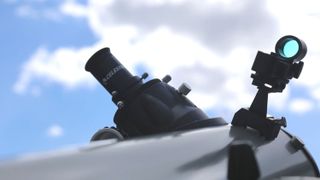
(Image credit: Jamie Carter)
The StarSense Explorer DX 130AZ is a Newtonian reflector telescope with a 5.1-inch aperture. In terms of magnification that’s a significant step-up from the ‘toy’ telescopes that dominate the beginner’s market. However, this is a telescope definitely aimed at beginners; that much is obvious from the basic 25mm and 10mm eyepieces supplied with it.
(Image credit: Jamie Carter)
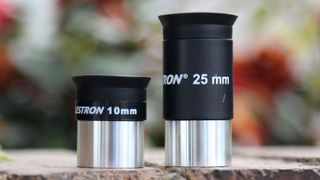
(Image credit: Jamie Carter)
Everything you need to go view the night sky is included in the box. There’s a sturdy tripod with extending legs, the telescope tube, two eyepieces and a small fabric drawstring bag for storing them in.
However, almost all users will be using the StarSense app, which is a free app for your smartphone. It’s really easy to use; you just put your smartphone in the mount, tell the app which telescope you have and take the cover off the mirror just below it.
Celestron StarSense Explorer DX 130AZ: specs
Optical design:Newtonian Reflector
Objective lens diameter (aperture):5.11"/130mm
Focal length:25.59"/650mm
Focal ratio:f5
Software supplied:StarSense Explorer app
Mount:manual alt-az
Weight:18 lbs / 8.16 kg
Level:beginner
Celestron StarSense Explorer DX 130AZ review: set-up and use
(Image credit: Jamie Carter)
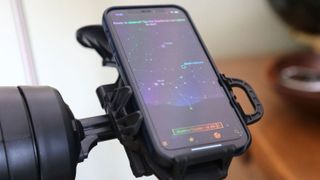
(Image credit: Jamie Carter)
Celestron claims that it takes about 15 minutes to set-up the StarSense Explorer DX 130AZ from scratch and we found that to be largely true. It’s a cinch to position the tripod and screw the various components to it. The only issue we had was that we initially placed it all on some decking, which wobbled about a bit as we walked around the ‘scope, upsetting the alignment process. Placed on hard-standing it worked swiftly, allowing us to select objects from a ‘tonight’ list.
We then followed some simple arrows on the phone app to move the StarSense Explorer DX 130AZ into position using its manual alt-azimuth mount. Once you get close the app suddenly zooms in and it’s then necessary to use a couple of wobbly motor control sticks poking out of the mount to gradually adjust the axis to get the telescope bang-on your target. Confirming it all visually through the 25mm eyepiece is a little confusing at first if you’re a beginner because Newtonian reflector telescopes always show objects upside down.
(Image credit: Jamie Carter)

(Image credit: Jamie Carter)
The way the app works with the telescope takes a little getting to know, but it’s a process that comes naturally after a few attempts. Although it worked for us for the first few moonless nights in a city, it became less effective as the Moon waxed past its First Quarter phase and towards its full phase. Telescopes always work better(and give better views) in dark skies and the StarSense Explorer DX 130AZ is no different.
Celestron StarSense Explorer DX 130AZ review: performance
(Image credit: Jamie Carter)
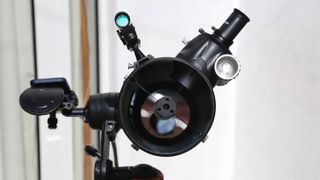
(Image credit: Jamie Carter)
The drawback of being a manual telescope is that it doesn’t stay trained on an object. Instead, you have to keep nudging those knobs to keep your target centred. That goes triple for the Moon, which quickly moves out of view. However, put the StarSense Explorer DX 130AZ on the shadowed craters on the lunar surface in the 25mm eyepiece and the results are outstandingly sharp. Not so the 10mm eyepiece, which is rather blurry.
One drawback is that the Netwonian reflectors’ optics do occasionally require collimating, which is going to be off-putting for beginners. However, there’s a YouTube video for that.
Celestron StarSense Explorer DX 130AZ review: alternatives to consider
A close cousin of the StarSense Explorer DX 130AZ is the more affordable SkyWatcher Explorer 130M, another Newtonian reflector telescope aimed at beginners that trades smartphone aligning for a motorised equatorial mount. Instead of an app this ‘go to’ telescope has a handset from which you choose which targets you want to ‘scope to automatically slew to.
If money isn’t a problem and you want to indulge in super-simple deep-sky astrophotography then check out theUnistellar eVscope 2, a very expensive ‘smart’ telescope that can be entirely controlled using a smartphone. It’s fitted with aSonycamera sensor so it constantly takes images of the night sky and sends its results to your phone.
Celestron StarSense Explorer DX 130AZ review: verdict
(Image credit: Jamie Carter)
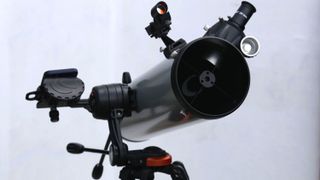
(Image credit: Jamie Carter)
If we’re all carrying around a planetarium in our pockets then what’s the point of replicating that in a telescope? That’s the thinking behind the StarSense Explorer DX 130AZ, which is relatively easy to use and gives impressively sharp views of the night sky.
Most beginners wouldn’t choose a completely manual telescope as their first, but with an excellent app to help the StarSense Explorer DX 130AZ not only gives sharp views but also helps you actually learn how to navigate the night sky. Isn’t that what most of us wanted in the first place?
Celestron StarSense Explorer DX 130AZ Smartphone App-Enabled Telescope: Price Comparison
$365.49View$365.49View$479.95$365.99View
$365.49View
$365.49View



$365.49View
$365.49
$365.49
$365.49View
$365.49View


$365.49View
$365.49
$365.49
$479.95$365.99View
$479.95$365.99View


$479.95$365.99View
$479.95$365.99
$365.99
We check over 250 million products every day for the best prices
Sign up to the T3 newsletter for smarter living straight to your inbox
Get all the latest news, reviews, deals and buying guides on gorgeous tech, home and active products from the T3 experts

Campfire’s new premium buds put Nine Inch Nails into your earsCampfire’s cutting-edge IEMs are not something you can never have
Campfire’s cutting-edge IEMs are not something you can never have

You only need two dumbbells and this 30-minute workout to grow your glutes at home

New Samsung Galaxy S25 marketing images show all phones in close-up detailNew leak reveals more on the Samsung Galaxy S25 Ultra and standard models
New leak reveals more on the Samsung Galaxy S25 Ultra and standard models
